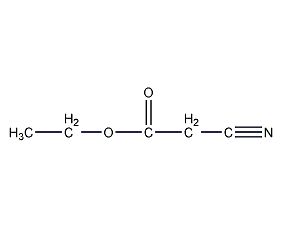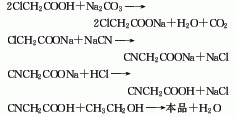
Structural formula
| Business number | 02RX |
|---|---|
| Molecular formula | C5H7NO2 |
| Molecular weight | 113 |
| label |
Ethyl cyanoacetate |
Numbering system
CAS number:105-56-6
MDL number:MFCD00001940
EINECS number:203-309-0
RTECS number:AG4110000
BRN number:605871
PubChem number:24865300
Physical property data
1. Properties: colorless liquid with slight odor. [1]
2. Melting point (ºC): -22.5[2]
3. Boiling point (ºC): 206~208[3]
4. Relative density (water=1): 1.06[4]
5. Relative vapor density (air=1): 3.9[5]
6. Saturated vapor pressure (kPa): 2.00 (99ºC)[6]
7. Critical pressure (MPa): 3.34[7]
8. Octanol/water partition coefficient: 0.02[8]
9. Flash point (ºC): 110[9]
10. Ignition temperature (ºC): 555[ 10]
11. Solubility: Slightly soluble in water, soluble in alkali and ammonia, miscible in ethanol and ether. [11]
12. Heat of evaporation (KJ/mol, 100~200ºC): 64.9
13. Heat of combustion (KJ/mol, 25ºC) : 2659.0
14. Conductivity (S/m, 25ºC): 6.9×10-7
Toxicological data
1. Acute toxicity: rat oral LDLo: 400mg/kg; mouse peritoneal cavity LD50: 500mg/kg; rabbit subcutaneous LDLo: 1410mg/kg; guinea pig subcutaneous LD50: 1115mg/kg; amphibians – Frog subcutaneous LDLo: 4200mg/kg;
2. It is moderately toxic. Absorbed through the skin and causes skin inflammation. Avoid contact with skin and inhalation of vapor during use. The inhalation LC50 for mice is 550mg/m3. Experimental animals exhibit shortness of breath, tearing, drowsiness, listlessness, and unresponsiveness at low concentrations. When the concentration is high, breathing becomes extremely difficult, and death occurs after convulsions, struggling and jumping.
3. Acute toxicity [12]
LD50: 400~3200mg/kg (rat oral)
p>
LC50: 550mg/m3 (rat inhalation, 2h)
Ecological data
1. Ecotoxicity No data available
2. Biodegradability No data available
3 .Non-biodegradability No information available
4. Other harmful effects[13] This substance is harmful to the environment and should be specially Pay attention to water pollution.
Molecular structure data
1. Molar refractive index: 26.90
2. Molar volume (cm3/mol): 107.9
3. Isotonic specific volume (90.2K ): 264.1
4. Surface tension (dyne/cm): 35.8
5. Polarizability: 10.66
Compute chemical data
1. Reference value for hydrophobic parameter calculation (XlogP): 0.4
2. Number of hydrogen bond donors: 0
3. Number of hydrogen bond acceptors: 3
4. Number of rotatable chemical bonds: 3
5. Number of tautomers: none
6. Topological molecule polar surface area 50.1
7. Number of heavy atoms: 8
8. Surface charge: 0
9. Complexity: 122
10. Isotopic atoms�Quantity: 0
11. Determine the number of atomic stereocenters: 0
12. Uncertain number of atomic stereocenters: 0
13. Determine Number of stereocenters of chemical bonds: 0
14. Number of stereocenters of uncertain chemical bonds: 0
15. Number of covalent bond units: 1
Properties and stability
1. Chemical properties: Ethyl cyanoacetate contains active methylene, which reacts with bromine to form bromoethyl cyanoacetate. It reacts with ammonia to form cyanoacetamide. It reacts with ethanol-sulfuric acid to form diethyl malonate. Less acidic than phenol. Hydrolysis can occur in the presence of acid and alkali. In addition, ethyl cyanoacetate can undergo polycondensation reactions with formaldehyde, acetaldehyde or other aldehydes and ketones.
2. Stability[14] Stable
3. Incompatible substances[15] Strong oxidizing agent, strong reducing agent, strong acid, strong alkali
4. Conditions to avoid contact [16] Moisture Air
5. Polymerization hazard[17] Does not polymerize
6. Decomposition products[18 ] Cyanide
Storage method
Storage Precautions[19] Store in a cool, ventilated warehouse. Keep away from fire and heat sources. Keep container tightly sealed. They should be stored separately from oxidants, reducing agents, acids, alkalis, and food chemicals, and avoid mixed storage. Equipped with the appropriate variety and quantity of fire equipment. The storage area should be equipped with emergency release equipment and suitable containment materials.
Synthesis method
It is produced by esterifying chloroacetic acid and ethanol to produce ethyl chloroacetate, and then reacting with sodium cyanide. It can also be obtained by direct esterification of cyanoacetic acid and ethanol.
Process flow: 1. Chloroacetic acid esterification and cyanation method: esterification reaction of chloroacetic acid and ethanol to generate ethyl chloroacetate. The refined ethyl chloroacetate is cyanated with sodium cyanide. chemical reaction to obtain crude ethyl cyanoacetate, which is then filtered, distilled under normal pressure, and rectified under reduced pressure to obtain fine ethyl cyanoacetate.

2. Chloroacetate cyanide The chloroacetic acid is neutralized with soda ash to produce sodium chloroacetate, which is then reacted with sodium cyanide to produce sodium cyanoacetate, then acidified with hydrochloric acid to obtain cyanoacetic acid, and finally esterified with ethanol to obtain ethyl cyanoacetate. After filtration and normal pressure Distillation and vacuum distillation to obtain the finished product.
Refining method: dry with potassium carbonate or anhydrous sodium sulfate and then fractionate.

Purpose
1. Mainly used as raw materials for organic synthesis. It is used in medicine as an intermediate for the synthesis of caffeine and vitamin B6. It is also used as oil-soluble coupler for color film, synthetic binder, raw material and analytical reagent.
2. Used in organic synthesis, pharmaceutical industry and dye industry. [20]


